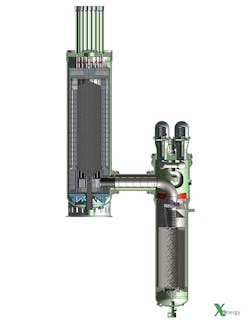X-energy selects contractors to design and build Xe-100 Advanced Nuclear Reactor projects
Supporters for advanced and small modular reactors are enthusiastic that this form of nuclear group will strengthen the journey toward Net-Zero goals by offering a reliable, baseload and carbon-free power generation resource.
Detractors worry about safety and cost issues, as well as the fact that no such SMR projects are currently operational.
One such effort to rectify that last point is making headway toward becoming a reality. X-energy, one of several advanced reactor developers moving toward demonstrations by end of the decade, has selected a team combining three global-level engineering, procurement and construction (EPC) contractors to collaborate on design and deployment of the prospective Xe-100 fleet.
Contractors Zachry Group will join with a combined team of Burns & McDonnell and Day & Zimmerman as constructors for the Xe-100 advanced reactor. X-energy announced last year an agreement with Canadian utility Ontario Power Generation to pursue deployment of the model for industrial applications.
“Selecting and partnering with our constructors this early in the development process is a paradigm shift for the entire nuclear energy industry,” said Clay Sell, CEO of X-energy. “We will collaborate and work side-by-side with these firms to ensure the successful design and delivery of the first and subsequent Xe-100 deployments.”
Companies in the advanced nuclear reactor sector tout the SMRs as offering dispatchable power at utility-scale levels with smaller footprints and costs than conventional nuclear power plants such as the new, estimated $30 billion Vogtle 3 and 4 project in Georgia. Some industry insiders, including former Energy Secretary Ernest Moniz, have suggested it will be difficult and maybe impossible for the U.S. to reach electric-sector zero carbon emissions goals without nuclear power in the mix.
Rockville, Maryland-based X-energy’s Xe-100 is a high-temperature gas reactor engineered to operate as a single 80 MW electric unit and can be optimized a four-unit plant delivering 320 MW in electricity capacity. Two years ago, X-energy was selected by the U.S. Department of Energy’s Advanced Reactor Demonstration Program to deliver a four-unit Xe-100 plant in Washington state, which will make it the first operational grid-scale advanced reactor plant in North America.
X-energy part of putting Nuclear Fission on the Moon?
The EPC team of Zachry and the combined Burns & McDonnell-Day & Zimmerman unit will work with suppliers and X-Energy in all phases of design, equipment supply, fabrication and construction.
Kansas City, Missouri-based Burns & McDonnell is more than 120 years old and has worked on EPC contracts for numerous nuclear power plant owners.
“Advanced nuclear must be part of our future energy solutions as we decarbonize as a society,” Ray Kowalik, Burns & McDonnell CEO, said in a statement. “The cost of nuclear needs to be competitive in the market and predictable. Bringing advanced construction planning into the development process is the right approach to accomplish the safety, price, schedule and quality needed for this technology.”
More on the Future Role for Next-gen Nuclear in the Energy Transition
Pro-Nuclear Group argues SMRs offer Cost-Effective, Carbon-Free and Baseload Path to Net Zero
Are Nuclear-Powered Data Centers on the Horizon?
Last Energy, Enea Group developing SMR projects in Poland
Subscribe to EnergyTech's free newsletter for more stories on the C&I Energy Transition
In October, 2020, the U.S. Department of Energy awarded X-energy $80 million from the Advanced Reactor Demonstration Program. TerraPower was the other ARDP awardee.
Last year, the Pacific Northwest combination of Energy Northwest and utility Grant County Public Utility District signed a memorandum of understanding on a partnership to develop an advanced nuclear reactor project.
Nuclear energy generates close to 20 percent of the U.S. electricity mix and more than half of its carbon-free generation, according to reports. Nuclear provides close to 15 percent of the electricity created in Canada.
-- -- --
(Rod Walton, senior editor for EnergyTech, is a 14-year veteran of covering the energy industry both as a newspaper and trade journalist. He can be reached at [email protected]).
About the Author
Rod Walton, EnergyTech Managing Editor
Managing Editor
For EnergyTech editorial inquiries, please contact Managing Editor Rod Walton at [email protected].
Rod Walton has spent 17 years covering the energy industry as a newspaper and trade journalist. He formerly was energy writer and business editor at the Tulsa World. Later, he spent six years covering the electricity power sector for Pennwell and Clarion Events. He joined Endeavor and EnergyTech in November 2021.
Walton earned his Bachelors degree in journalism from the University of Oklahoma. His career stops include the Moore American, Bartlesville Examiner-Enterprise, Wagoner Tribune and Tulsa World.
EnergyTech is focused on the mission critical and large-scale energy users and their sustainability and resiliency goals. These include the commercial and industrial sectors, as well as the military, universities, data centers and microgrids. The C&I sectors together account for close to 30 percent of greenhouse gas emissions in the U.S.
He was named Managing Editor for Microgrid Knowledge and EnergyTech starting July 1, 2023
Many large-scale energy users such as Fortune 500 companies, and mission-critical users such as military bases, universities, healthcare facilities, public safety and data centers, shifting their energy priorities to reach net-zero carbon goals within the coming decades. These include plans for renewable energy power purchase agreements, but also on-site resiliency projects such as microgrids, combined heat and power, rooftop solar, energy storage, digitalization and building efficiency upgrades.

